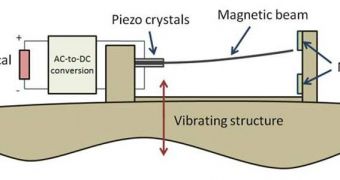Piezoelectric devices are well known for their ability to convert mechanical stress into electricity, and a great many research groups around the world are currently working on developing their technology to a point where it could be used in mass applications. Scientists at the Virginia Polytechnic Institute (VPI), in Blacksburg, Virginia, have recently developed a tiny piezoelectric device that is able to harness the power generated by small vibrations, and that could become of tremendous use in tomorrow's small-scale robots, probes and appliances, LiveScience informs.
Needles to say, collecting the energy of small vibrations could potentially lead to the development of self-charging batteries that needn't be connected to a recharger in order to work. Since most of these objects are used nowadays inside portable game consoles, mobile phones, laptops or radio instruments, carrying them around makes them vibrate, albeit on a small scale. The new VPI device could harness this energy, and essentially recharge the batteries as the object is being moved from one place to the other in a bag or pocket. Details of the new apparatus appear in the latest issue of the journal Applied Physics Letters.
There are several types of materials that exhibit piezoelectric properties, but, most commonly, experts use special types of ceramics and crystals for the job. When mechanical stress is applied to these structures, it generates a variation in their electric field, which can be then transmitted to an electrical storage unit, such as a battery. For instance, crystals could be placed under highly circulated sidewalks, and could provide the energy requirements of the stores located on that specific street. Essentially, they can be placed anywhere where continuous activity takes place.
But the VPI instruments are devised under two funds, of which one is from the US Air Force. The USAF plans to use the devices to harness the vibrations that appear at the tip of the wings of unmanned reconnaissance planes, which could therefore stay in the air for longer. The National Institute of Standards and Technology (NIST) is the other funder, and the agency plans to use the piezoelectrics on bridges, so as to harness the power of intense traffic bottlenecks.

 14 DAY TRIAL //
14 DAY TRIAL //